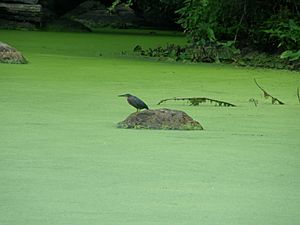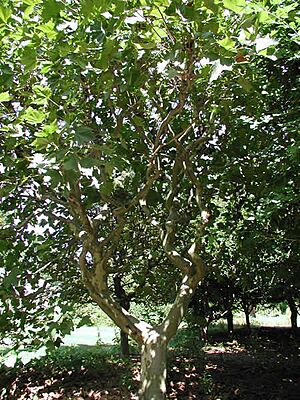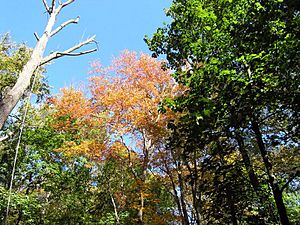Bartlett Arboretum and Gardens facts for kids
Quick facts for kids Bartlett Arboretum and Gardens |
|
|---|---|

Bartlett Homestead
|
|
| Type | Arboretum |
| Location | Stamford, Connecticut |
| Area | 93 acres (38 ha) |
| Website | Bartlett Arboretum & Gardens |
The Bartlett Arboretum and Gardens in Stamford, Connecticut is a wonderful place to explore nature. It has 93 acres of parkland, beautiful gardens, and fun hiking trails. This special spot focuses on the plants, wildlife, and natural features of Southwestern New England. The Arboretum is open to everyone, every day of the year!
History of the Arboretum
The Arboretum began in 1913. Dr. Francis A. Bartlett, a famous tree expert, bought about 30 acres of woodland in North Stamford. He used this land as his home, a training school, and a research lab for his tree company. Over the years, he gathered many different plant types from all over the world for the property.
In 1965, his research lab moved to North Carolina. The Stamford site, which had grown to over 60 acres, was bought by the State of Connecticut. It was then named the Connecticut State Arboretum.
Later, in 1993, the land and its operations were given to the University of Connecticut at Stamford. Then, in 2001, the land went to the City of Stamford. The daily running of the Arboretum was taken over by the Bartlett Arboretum Association. This is a non-profit group that still manages the grounds today.
Since 2006, the Arboretum has continued its research programs. These programs study local plant life, like how different plants grow in Connecticut forests. They also look at how tropical plants live and change over time.
Amazing Plant Collections
The Arboretum is home to many different groups of plants. Here are some of the special collections you can see:
- The Conifer Garden has many types of cone-bearing trees. These include Tsuga (hemlock), Pinus (pine), Picea (spruce), Abies (fir), and Juniperus (juniper).
- The Mehlquist Garden features a unique collection of Rhododendrons and Azaleas. These come from different parts of the world, including Japan, Korea, and Europe.
- The Nut Tree Collection was planted by Francis Bartlett himself. It includes pecans, walnuts, filberts, and a strong Chestnut hybrid.
- The Pollarded Tree Display shows deciduous trees that are kept small. This is done using a special pruning method called pollarding.
- The Magnolia Collection is a newer area along the entrance road. It has many kinds of magnolia trees.
- The Theaceae collection was added in 2007. It includes different species from the Tea family, like Camellias and Stewartias.
Natural Habitats to Explore

The Arboretum has several natural areas where you can see different plants and animals:
- The Arboretum’s Meadow is a special managed area. Long ago, old farm fields turned into wildflower meadows. These meadows were full of birds, bees, and butterflies. The Arboretum created this meadow in 2000. It's a great example of a beautiful and natural space that helps wildlife. Depending on the time of year, you might see wildflowers like Coreopsis, Black-eyed Susan, and Lupine. The meadow is mowed once a year to keep it from turning back into a forest.
- The Woodland Pond was made by a dam. Water collects here before flowing into Poorhouse Brook and then to Long Island Sound. A pond is a small body of water where plants can grow from the bottom to the surface. In summer, you might see the round leaves and pink flowers of Pond Lilies. You might also spot arrow-shaped leaves of Arrow Arum around the edges.
- The Red Maple Wetland is a favorite spot for nature lovers. It's one of the few Red Maple swamps in the area that hasn't been changed much by buildings or non-native plants.
See also
 In Spanish: Arboreto y jardines Bartlett para niños
In Spanish: Arboreto y jardines Bartlett para niños



